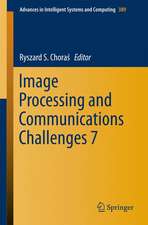The SAGE Handbook of Remote Sensing
Editat de Timothy A Warner, M. Duane Nellis, Giles M Foodyen Limba Engleză Hardback – 17 iun 2009
Remote Sensing acquires and interprets small or large-scale data about the Earth from a distance. Using a wide range of spatial, spectral, temporal, and radiometric scales Remote Sensing is a large and diverse field for which this Handbook will be the key research reference.
Organized in four key sections:
• Interactions of Electromagnetic Radiation with the Terrestrial Environment: chapters on Visible, Near-IR and Shortwave IR; Middle IR (3-5 micrometers); Thermal IR ; Microwave
• Digital sensors and Image Characteristics: chapters on Sensor Technology; Coarse Spatial Resolution Optical Sensors ; Medium Spatial Resolution Optical Sensors; Fine Spatial Resolution Optical Sensors; Video Imaging and Multispectral Digital Photography; Hyperspectral Sensors; Radar and Passive Microwave Sensors; Lidar
• Remote Sensing Analysis - Design and Implementation: chapters on Image Pre-Processing; Ground Data Collection; Integration with GIS; Quantitative Models in Remote Sensing; Validation and accuracy assessment;
• Remote Sensing Analysis - Applications: LITHOSPHERIC SCIENCES: chapters on Topography; Geology; Soils; PLANT SCIENCES: Vegetation; Agriculture; HYDROSPHERIC and CRYSOPHERIC SCIENCES: Hydrosphere: Fresh and Ocean Water; Cryosphere; GLOBAL CHANGE AND HUMAN ENVIRONMENTS: Earth Systems; Human Environments & Links to the Social Sciences; Real Time Monitoring Systems and Disaster Management; Land Cover Change
Illustrated throughout, an essential resource for the analysis of remotely sensed data, the SAGE Handbook of Remote Sensing provides researchers with a definitive statement of the core concepts and methodologies in the discipline.
Preț: 958.68 lei
Preț vechi: 1295.51 lei
-26% Nou
Puncte Express: 1438
Preț estimativ în valută:
183.48€ • 191.04$ • 155.06£
183.48€ • 191.04$ • 155.06£
Carte tipărită la comandă
Livrare economică 10-24 martie
Preluare comenzi: 021 569.72.76
Specificații
ISBN-13: 9781412936163
ISBN-10: 1412936160
Pagini: 568
Dimensiuni: 184 x 246 x 36 mm
Greutate: 1.2 kg
Ediția:First Edition
Editura: SAGE Publications
Colecția Sage Publications Ltd
Locul publicării:London, United Kingdom
ISBN-10: 1412936160
Pagini: 568
Dimensiuni: 184 x 246 x 36 mm
Greutate: 1.2 kg
Ediția:First Edition
Editura: SAGE Publications
Colecția Sage Publications Ltd
Locul publicării:London, United Kingdom
Recenzii
A magnificent achievement. A who's who of contemporary remote sensing have produced an engaging, wide-ranging and scholarly review of the field in just one volume
Professor Paul Curran
Vice-Chancellor, Bournemouth University
This volume covers all the main fields of remote sensing in a very comprehendible
manner. Most of the chapters are presented in a semi-historic account that
shows the development of the field or in methods of data processing. The discussion
is accompanied by high-quality color images and graphs in order to provide as
full coverage of the topics as possible. The structure of the book is organized very
systematically into sections, sub-sections and chapters. It may thus be used as a text
book in various courses of remote sensing or as a book for independent learning in
advanced studies. The target audiences are students and researchers from different
fields such as geography, geology, and the natural and engineering science.
Yitzhak August
Geography Research Forum
Professor Paul Curran
Vice-Chancellor, Bournemouth University
This volume covers all the main fields of remote sensing in a very comprehendible
manner. Most of the chapters are presented in a semi-historic account that
shows the development of the field or in methods of data processing. The discussion
is accompanied by high-quality color images and graphs in order to provide as
full coverage of the topics as possible. The structure of the book is organized very
systematically into sections, sub-sections and chapters. It may thus be used as a text
book in various courses of remote sensing or as a book for independent learning in
advanced studies. The target audiences are students and researchers from different
fields such as geography, geology, and the natural and engineering science.
Yitzhak August
Geography Research Forum
Cuprins
Remote Sensing Data Selection Issues - Timothy A. Warner, Duane Nellis, and Giles M. Foody
PART ONE: INTRODUCTION
Remote Sensing Data Selection Issues - Timothy A. Warner, Duane Nellis, and Giles M. Foody
Remote Sensing Policy - Ray Harris
PART TWO: ELECTROMAGNETIC RADIATION & THE TERRESTRIAL ENVIRONMENT
Visible, Near-IR & Shortwave IR Spectral Characteristics of Terrestrial Surfaces - Willem van Leeuwen
Interactions of Middle Infrared (3-5µm) Radiation with the Environment - Arthur Cracknell and D. S. Boyd
Thermal Remote Sensing in Earth Science Research - Dale Quattrochi and Jeffrey C. Luvall
Polarimetric SAR Phenomenology and Inversion Techniques for Vegetated Terrain - Mahta Moghaddam
PART THREE: DIGITAL SENSORS AND IMAGE CHARACTERISTICS
Optical Sensor Technology - John Kerekes
Fine spatial resolution optical sensors - Thierry Toutin
Moderate Spatial Resolution Optical Sensors - Samuel N. Goward, Terry Arvidson, Darrel L. Williams, Richard Irish and Jim Irons
Coarse Resolution Optical Sensors - Chris Justice and Compton Tucker
Airborne Digital Multispectral Imaging - Doug Stow, Lloyd L. Coulter and Cody A. Benkelman
PART FOUR: REMOTE SENSING ANALYSIS: DESIGN AND IMPLEMENTATION
Imaging Spectrometers - Michael Schaepma
Active and Passive Microwave Systems - Josef Kellndorfer and Kyle McDonald
Airborne Laser Scanning - Juha Hyyppä, W. Wagner, M. Hollaus and H. Hyyppä
Radiometry and reflectance: From terminology concepts to measured quantities - Gabriela Schaepman-Strub, Michael E. Schaepman, John V. Martonchik, Thomas H. Painter and Stefan Dangel
Pre-Processing of Optical Imagery - Freek van der Meer and Harald van der Werff and Steven de Jong
Surface Reference Data Collection - Chris Johannsen and Craig S. T. Daughtry
Integrating Remote Sensing and Geographic Information Systems - James Merchant and Sunil Narumalani
Image Classification - John Jensen, Jungho Im, Perry Hardin, Ryan R. Jensen
Quantitative Models and Inversion in Optical Remote Sensing - Shunlin Liang
Accuracy Assessment - Steve Stehman, Giles Foody
PART FIVE: REMOTE SENSING ANALYSIS: APPLICATIONS
A. LITHOSPHERIC SCIENCES
Making Sense of the Third Dimension Through Topographic Analysis - Yongxin Deng
Remote Sensing of Geology - Xianfeng Chen and David Campagna
Remote Sensing of Soils - Jim Campbell
B. PLANT SCIENCES
Remote sensing for studies of vegetation condition: Theory and application - Mike Wulder, Joanne C. White, Nicholas C. Coops and Stephanie Ortlepp
Remote Sensing of Cropland Agriculture - M. Duane Nellis, Kevin Price and Don Rundquist
C. HYDROSPHERIC & CRYSOPHERIC SCIENCES
Optical Remote Sensing of the Hydrosphere: From the open ocean to inland waters - Samantha Lavender
Remote Sensing of the Cryosphere - Jeff Dozier
D. GLOBAL CHANGE AND HUMAN ENVIRONMENTS
Remote Sensing for Terrestrial Biogeochemical Modeling - Greg Asner and Scott V. Ollinger
Remote Sensing of Urban Areas - Janet Nichol
Remote sensing and the social sciences - Kelley Crews and Stephen J. Walsh
Hazard Assessment and Disaster Management using Remote Sensing - Richard Teeuw, Paul Aplin, Nick McWilliam, Toby Wicks, Matthieu Kervyn and Gerald Ernst
Remote Sensing of Land Cover Change - Timothy A. Warner, Abdullah Almutairi and Jong Yeol Lee
PART SIX:. CONCLUSIONS
Remote Sensing: A Look to the Future - Giles M. Foody, Timothy A. Warner and M. Duane Nellis
PART ONE: INTRODUCTION
Remote Sensing Data Selection Issues - Timothy A. Warner, Duane Nellis, and Giles M. Foody
Remote Sensing Policy - Ray Harris
PART TWO: ELECTROMAGNETIC RADIATION & THE TERRESTRIAL ENVIRONMENT
Visible, Near-IR & Shortwave IR Spectral Characteristics of Terrestrial Surfaces - Willem van Leeuwen
Interactions of Middle Infrared (3-5µm) Radiation with the Environment - Arthur Cracknell and D. S. Boyd
Thermal Remote Sensing in Earth Science Research - Dale Quattrochi and Jeffrey C. Luvall
Polarimetric SAR Phenomenology and Inversion Techniques for Vegetated Terrain - Mahta Moghaddam
PART THREE: DIGITAL SENSORS AND IMAGE CHARACTERISTICS
Optical Sensor Technology - John Kerekes
Fine spatial resolution optical sensors - Thierry Toutin
Moderate Spatial Resolution Optical Sensors - Samuel N. Goward, Terry Arvidson, Darrel L. Williams, Richard Irish and Jim Irons
Coarse Resolution Optical Sensors - Chris Justice and Compton Tucker
Airborne Digital Multispectral Imaging - Doug Stow, Lloyd L. Coulter and Cody A. Benkelman
PART FOUR: REMOTE SENSING ANALYSIS: DESIGN AND IMPLEMENTATION
Imaging Spectrometers - Michael Schaepma
Active and Passive Microwave Systems - Josef Kellndorfer and Kyle McDonald
Airborne Laser Scanning - Juha Hyyppä, W. Wagner, M. Hollaus and H. Hyyppä
Radiometry and reflectance: From terminology concepts to measured quantities - Gabriela Schaepman-Strub, Michael E. Schaepman, John V. Martonchik, Thomas H. Painter and Stefan Dangel
Pre-Processing of Optical Imagery - Freek van der Meer and Harald van der Werff and Steven de Jong
Surface Reference Data Collection - Chris Johannsen and Craig S. T. Daughtry
Integrating Remote Sensing and Geographic Information Systems - James Merchant and Sunil Narumalani
Image Classification - John Jensen, Jungho Im, Perry Hardin, Ryan R. Jensen
Quantitative Models and Inversion in Optical Remote Sensing - Shunlin Liang
Accuracy Assessment - Steve Stehman, Giles Foody
PART FIVE: REMOTE SENSING ANALYSIS: APPLICATIONS
A. LITHOSPHERIC SCIENCES
Making Sense of the Third Dimension Through Topographic Analysis - Yongxin Deng
Remote Sensing of Geology - Xianfeng Chen and David Campagna
Remote Sensing of Soils - Jim Campbell
B. PLANT SCIENCES
Remote sensing for studies of vegetation condition: Theory and application - Mike Wulder, Joanne C. White, Nicholas C. Coops and Stephanie Ortlepp
Remote Sensing of Cropland Agriculture - M. Duane Nellis, Kevin Price and Don Rundquist
C. HYDROSPHERIC & CRYSOPHERIC SCIENCES
Optical Remote Sensing of the Hydrosphere: From the open ocean to inland waters - Samantha Lavender
Remote Sensing of the Cryosphere - Jeff Dozier
D. GLOBAL CHANGE AND HUMAN ENVIRONMENTS
Remote Sensing for Terrestrial Biogeochemical Modeling - Greg Asner and Scott V. Ollinger
Remote Sensing of Urban Areas - Janet Nichol
Remote sensing and the social sciences - Kelley Crews and Stephen J. Walsh
Hazard Assessment and Disaster Management using Remote Sensing - Richard Teeuw, Paul Aplin, Nick McWilliam, Toby Wicks, Matthieu Kervyn and Gerald Ernst
Remote Sensing of Land Cover Change - Timothy A. Warner, Abdullah Almutairi and Jong Yeol Lee
PART SIX:. CONCLUSIONS
Remote Sensing: A Look to the Future - Giles M. Foody, Timothy A. Warner and M. Duane Nellis
Descriere
This Handbook will fill an important niche in helping those in the remote sensing field stay current in this rapidly changing field.












